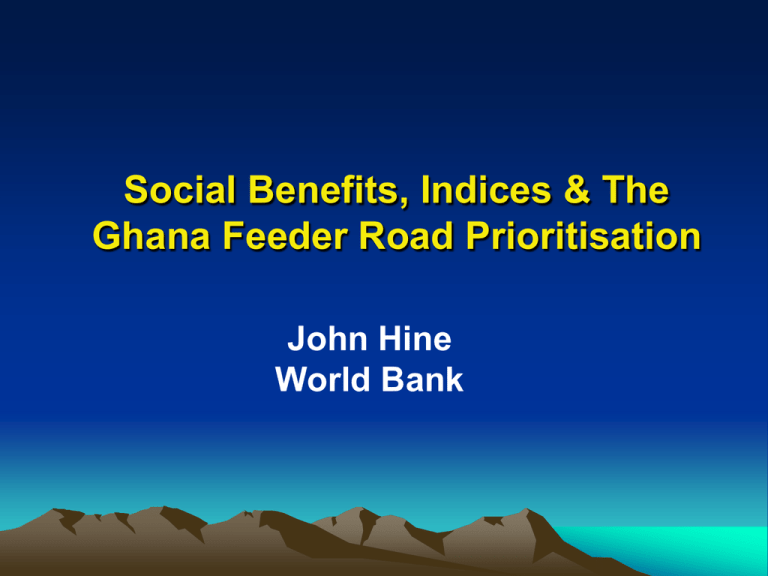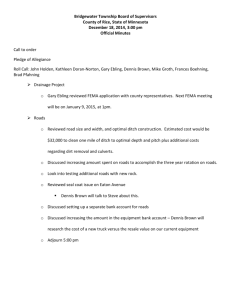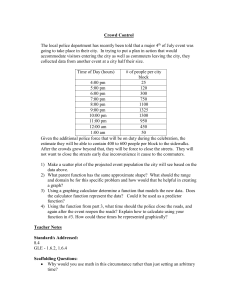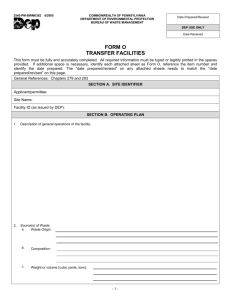are social benefits the missing component of road appraisal?
advertisement

Social Benefits, Indices & The Ghana Feeder Road Prioritisation John Hine World Bank Social Benefits: Why the Concern ? • There is unease with conventional appraisal based primarily on transport cost savings to traffic • There is a strong desire at both community level and national level for better access and mobility which is frequently not matched by standard measured economic benefits • All over the ‘rich’ world governments subsidise rural transport. Should the same happen for developing countries ? • Isolation is a recognised characteristic of poverty • There is a feeling that a minimum degree of access and mobility is a ‘basic human right’ • International development has moved away from a narrow definition of economic development towards concern with ‘livelihoods’ and meeting ‘Millennium Development Goals’ that are very health orientated • The issue is particularly important when roads are impassable to motor traffic. Economic & Social Benefits Consumers and producers surplus approaches are very economic in their orientation. Yet roads provide ‘social benefits’ – including improved access to health and education facilities and improved social mobility that cannot be easily translated into conventional economic benefits. – Although they may have important long term ‘economic’ consequences. Improved health and education and more secure social networks increase long term earning capabilities but so far the economic forecasting framework does not include this. When roads are impassable to motorized traffic we know that the quality of health care and schooling falls. Drug supply and supervision drops. Likewise no NGO, government agency or commercial enterprise will establish or support a service which cannot guarantee all year round access. Does road accessibility affect health (in Ethiopia)? SNNP Region life expectancy and road density Road density 200 150 100 50 0 30 35 40 45 50 Life expectancy 55 60 Indices and Ranking • Widely used for feeder road planning; there are many different approaches e.g. i) cost of improvement / population ii) estimated trips / cost Advantages: Speed , simplicity, transparency, many factors can be incorporated Disadvantages: How do we value widely different factors ? (adding up apples and pears); weightings are not stable ; cannot easily address questions of road standards, timing etc, ; possible double counting Two Indices i) Andhra Pradesh cost effectiveness = cost of upgrading/ population served But – no measure of condition change and no importance to traffic ii) Airey & Taylor 1st for impassable roads rank = cost per head of establishing basic access 2nd when access is there: prioritization index estimated trips x access change = -------------------------------------------rehabilitation cost per km Ghana -Background • DFID and Department of Feeder Roads wanted new planning procedure suitable for low volume feeder roads including a social dimension. • Road program was to be based primarily in Northern Ghana in an area of tribal conflict. – Previously ignored by authorities. • Existing procedures used based on producers surplus appeared arbitrary and not transparent. • Many roads and tracks were impassable for varying periods through the year – no traffic makes consumers surplus approach difficult to use The Requirements • Responsive to wishes of road users –rather than engineers or planners • Address poverty and gender issues • Equitable between all ethnic communities • Suitable for decentralisation decision making • Transparent • Simple • Economically rational • Robust based on objective measures • Makes engineering sense Approach An Outline of the 1 • Project covers 9 districts. 50 % of total money was initially to be issued equally between each district. In the second round the remaining money was to be allocated to roads in the whole area on the merits of each case. The approach is ‘budget limited’. • Community consultation is carried out in each district to determine a list of candidate roads – every road is a ‘wanted road’. • An engineering assessment is made of each candidate road to find the current state of accessibility and the costs of improvement • For each road traffic counts are carried out and census data examined to find adjacent population to benefit from the road improvement An Outline of the Approach 2 • Benefits are estimated from improving each road based on transport cost savings and additional ‘social’ benefits of better accessibility (based on population) • Two indices are constructed of benefits divided by costs for accessibility improvements and full rehabilitation. • An initial priority listing is prepared to spend available budget in each district based on the technical criteria. • Communities are asked to prepare separately their own priority listing. • The proposed lists are discussed at a public hearing. • An agreement is reached on which roads to build. • More detailed engineering design carried out. Outline of Approach 3 • Roads constructed for first round. • Second round roads are selected amongst the best candidate roads on the basis of the index not selected in the first round. • Poverty weighting comes into play because different districts have different poverty ratings. Consultation • NGOs are selected and training to carry out consultation • Team and NGOs meet District works Sub Committee who oversee process. • NGOs carry out interviews with service providers to learn about road condition. • NGOs contact communities and select representative people along with district nurses etc, willing to participate in the process. • In each Area (10 Areas to District) meetings are held to select two candidate roads per Area. • Later a District meeting is held to prioritise the roads from the 20 roads nominated in the District. • Finally a public hearing is held to discuss two priority lists prepared by public nominations and the technical analysis. The Index Benefits are the sum of traffic and social benefits per year. The index is: total benefits/ construction costs (accessibility improvements and full rehabilitation improvements are estimated separately) An adjustment is made to engineering costs for structures (x 0.5) because these last longer than other improvements The index is contained in an easy to use spread sheet. The Engineering Assessment • Local consulting engineers are selected and trained in the procedures. • They visit the road using the analysis sheets and identify key problems with a chainage. • The problems are divided into Access category A, B or C. • Category A – impassable roads, dangerous, road under water • Category B- access is possible but unreliable • Category C- access OK but surface attention required for roughness reduction • A costing is carried out and condition of road assessed in terms of roughness, passability and trafficability. Population & Traffic • Maps are consulted to identify roads and location of key facilities including markets health centres and hospitals • Local consultants selected to carry out two -day traffic counts on the roads • Counts cover pedestrians, NMTs, and vehicles • The Population in the catchment area of the road (i.e. adjacent and people living beyond the road who would use the road to go to key facilities). Transport Benefits • Transport benefits are calculated using fixed coefficients to show how change in road condition will reduce transport costs for existing traffic. • Benefits are given to both motor vehicles, pedestrians and NMTs. The assumption is that improved roads will encourage some switch of mode from walking and NMTs to motor vehicles • In periods of the year when the road is deemed impassable high transport benefits are given on the assumption that traffic has to divert some distance, or uses more expensive solutions (such as walking or NMTs.) Social Benefits • In addition to transport cost savings social benefits are given to road improvements to represent an improvement in the minimum degree of accessibility. The values were based on the assumption that 5 return vehicle trips per year represents an acceptable level of social trip making that may be added to existing traffic levels to cover a basic access social benefit component. (With 10 people per vehicle the weighting is ‘1’ assuming 10 single trips). • For roads with an average distance of more than 10 km from a health centre an ‘health isolation’ weighting of 0.5 is added • For roads with an average distance of more than 10 km from a market a ‘market isolation’ weighting of 0.1 is added • For the third of the districts with income levels below $325 (given in the Common Fund Allocation procedure) a weighting of 0.5 is added. • For all of the above the social benefits are dependent upon average transport cost savings (i.e. motor vehicle change in transport costs per km x distance) Experience of the Nanumba Trials • The procedure was found to work fairly well with a good degree of acceptability • For the available first round budget of $ 900,000 the Community District ranking for Nanumba would have selected 3 roads, 55 km with 8,383 beneficiaries. • In contrast the technical analysis selected 5 roads, 95 km benefiting 17,650 people. • At the public hearing it was agreed by all that the technical analysis was a better basis for planning. • However the community did draw attention to a major problem of one road where people were walking half a km up to their chest in water (not selected in the priority ranking). Documentation • The Procedure is well documented • 12 separate guides and manuals • And one spreadsheet to calculate the index • Contact jhine@worldbank.org if you want the full set.







